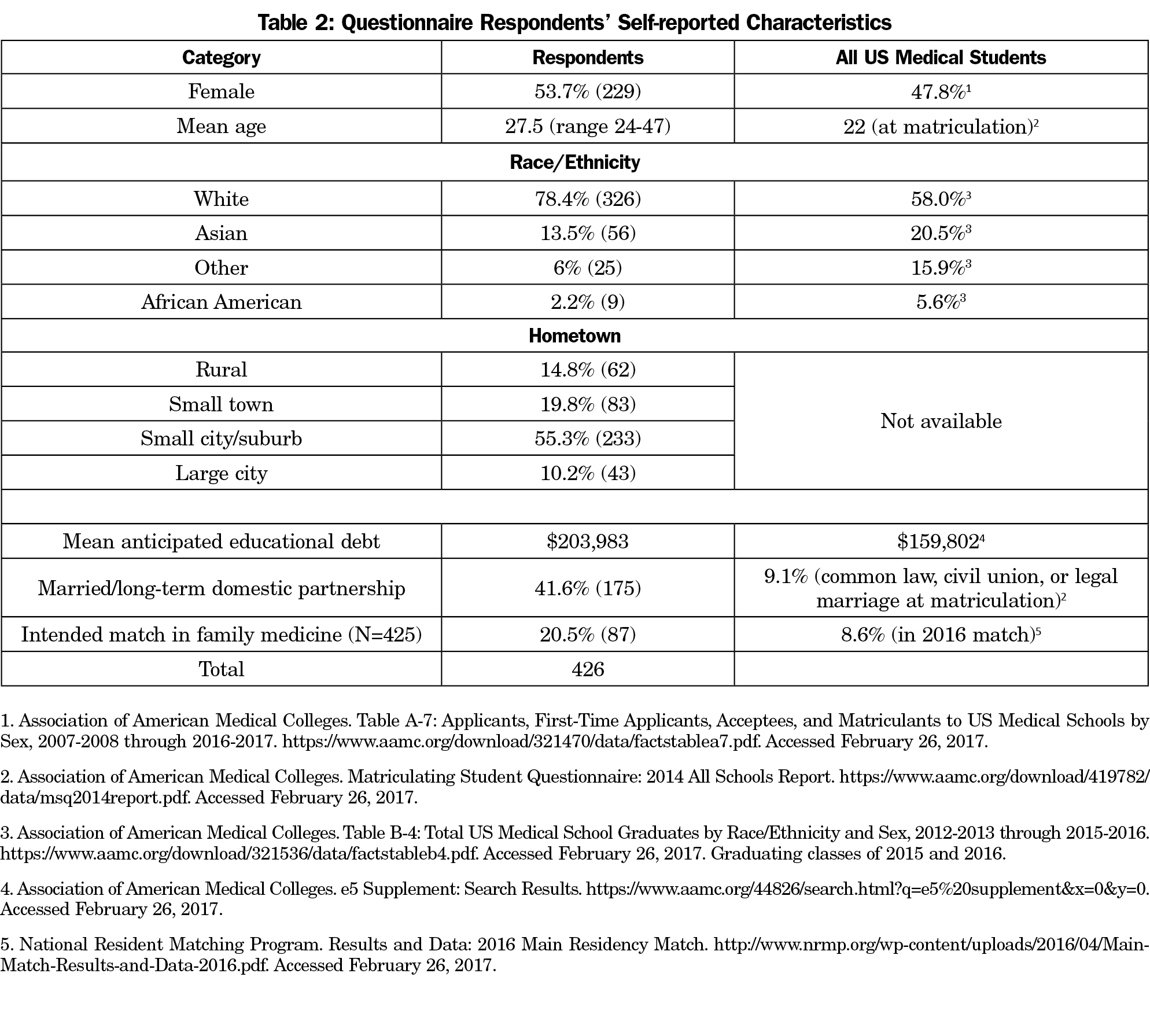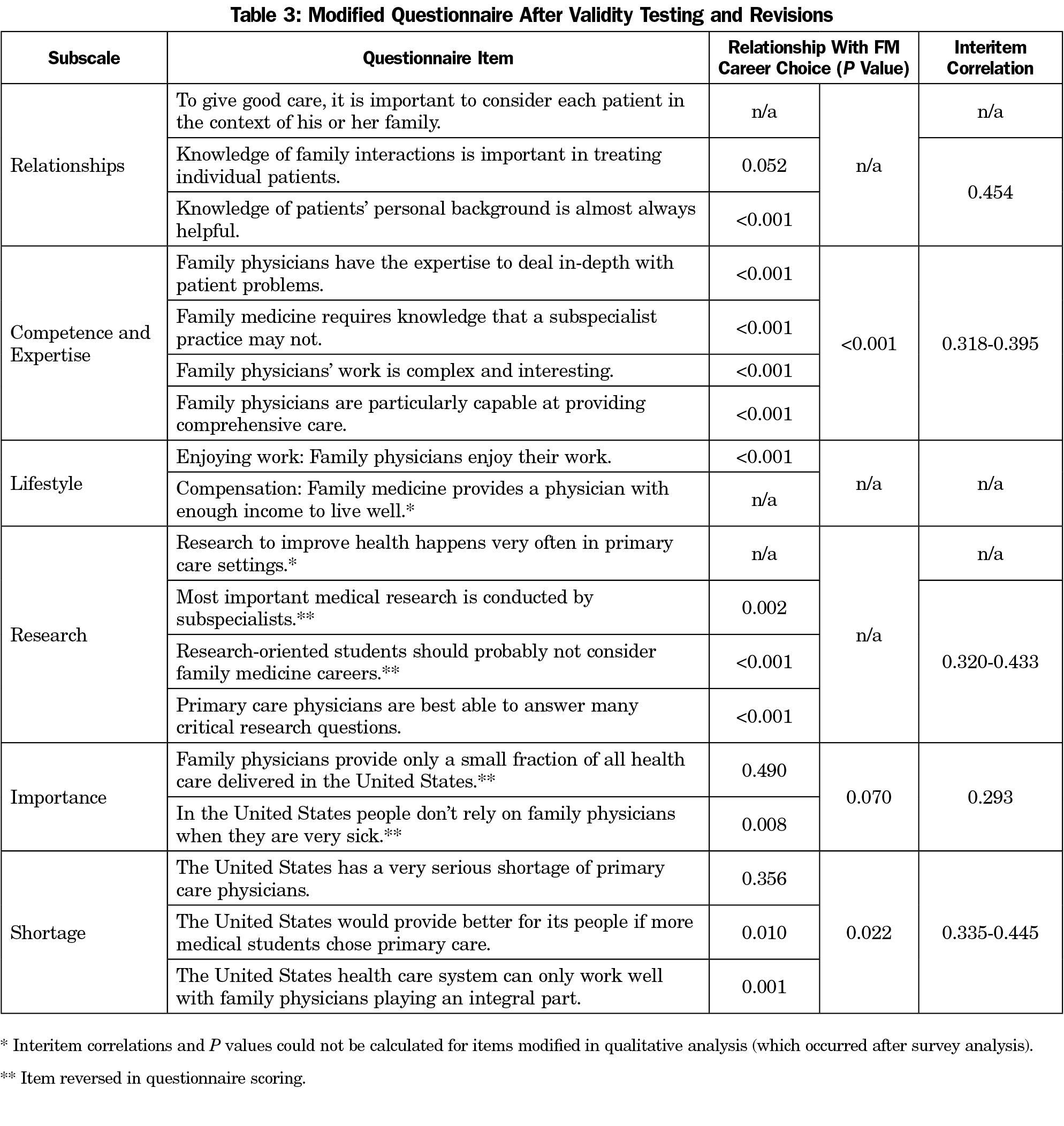Background and Objectives: Although many curricular and policy interventions are designed to influence students’ attitudes toward family medicine, assessment of these interventions is limited by lack of a comprehensive, validated measure of students’ attitudes. We sought to develop and validate a questionnaire that effectively assesses medical student attitudes toward family medicine.
Methods: A 31-item questionnaire was assessed for internal, external, and content validity. The questionnaire was offered to fourth-year students at two Midwestern medical schools. Internal validity was assessed using data reduction and iterative factor analyses. External validity was assessed by correlating scores with intention to match in family medicine. Content validity was assessed by directly observing students as they completed the questionnaire and qualitatively evaluating student comments.
Results: Of 858 students invited, 426 (49.7%) provided usable questionnaire data. After removal of questions with lower interitem correlations and simplification of subscales, the modified questionnaire achieved acceptable subscale internal consistency and a Cronbach alpha of 0.798. The overall instrument summative score correlated with family medicine career choice (P<0.001). Most subscales and individual items also correlated with family medicine choice. Ten students were directly observed, using an iterative process, and modifications were made based on student understanding.
Conclusions: Development of a validated questionnaire assessing medical student attitudes toward family medicine is feasible. With further refinement, the Family Medicine Attitudes Questionnaire may be useful in evaluating the impact of curricular interventions on students’ perceptions of family medicine, contributing to an evidence-based approach to recruitment of students to the specialty.
Medical students’ attitudes toward family medicine influence specialty choices. Students who pursue family medicine value continuity of care, holistic patient relationships, practice diversity, caring for complex and underserved patients, and work enjoyment; they place less emphasis on compensation.1-4 Students who pursue specialty careers are more influenced by greater prestige, income, procedural, and research opportunities.1 Increasing debt also decreases students’ willingness to pursue primary care.5-7 International studies suggest that globally, students value the social role of family medicine and are attracted to its patient-centered focus, versatility, and challenge.8-10 Community-based experiences, mentoring, curricular interventions, and institutional mission can all increase interest in family medicine.11-15
However, assessments of curricular and policy interventions designed to impact specialty choice are limited by lack of a comprehensive, validated measure of students’ attitudes toward family medicine. We sought to develop and validate a questionnaire that assesses student attitudes toward family medicine and predicts likelihood of family medicine career choice.
The questionnaire was initially developed in 2010, based on literature review and family medicine faculty feedback.16,17 Before assessing validity, we again comprehensively reviewed the literature and added items incorporating new evidence. The updated questionnaire included 31 items to be ranked on a 5-point scale from “strongly disagree” to “strongly agree”, categorized into seven subscales: relationships, competence, unique skills, lifestyle, research, importance, and shortage (Table 1). The “lifestyle” subscale was developed based on the work of Clinite et al, who defined lifestyle to include five components: enjoying work, work environment, financial compensation, schedule control, and time off.3
The questionnaire was offered to fourth-year students at the University of Minnesota (UMN) and Michigan State University College of Human Medicine (MSU-CHM) in 2015 and 2016, after submission of National Residency Matching Program rank lists. UMN and MSU-CHM are Midwestern land-grant allopathic medical schools chosen for convenience and relatively high proportion of students choosing family medicine. MSU-CHM students were surveyed on paper in 2015 and electronically in 2016; UMN students were surveyed electronically both years. When students were surveyed electronically, they were sent two reminders to encourage questionnaire completion. We collected respondent demographic and specialty choice information following questionnaire completion. Data were collected anonymously. We assessed questionnaire internal, external, and content validity.
We assessed internal validity using data reduction and iterative factor analyses. We examined the whole questionnaire and each individual item for validity by evaluating factor loading and interitem correlations of subscales.
We assessed external validity by correlating questionnaire score with intention to match in family medicine. We calculated questionnaire scores by summing responses to items (reversing negative items). Independent subscale scores were calculated by summing subscale responses. Independent samples t-tests were used to correlate scores and individual items with family medicine career choice.
All MSU-CHM students were invited by e-mail to participate in a direct observation assessment. Students were selected for diversity of year in school, age, hometown size, race/ethnicity, gender, family income, expected educational debt, marital status, and family medicine interest. A research assistant (Fitzpatrick) directly observed students completing the questionnaire, then asked them to describe their interpretation of each item and reasons for answering each item as they did. The research assistant took notes and responses were audio recorded, transcribed, and analyzed independently by two investigators (Phillips and Prunuske). Using an editing approach, researchers looked for evidence that students understood the intended meaning of the item, evidence of misunderstanding, and homogeneity of understanding. After the questionnaire was modified, further interviews were performed to reevaluate content validity.
The study was approved by the MSU-CHM and UMN Institutional Review Boards.
Of 858 students invited, 426 (49.7%) provided usable questionnaire data (A few responses were too incomplete to be used). Respondent and comparison national demographics are shown in Table 2. Compared to all US medical students graduating in 2015 and 2016, respondents were more likely to be white, female, have high debt, and choose family medicine.
Initial questionnaire Cronbach alpha was 0.796. Data reduction and factor analyses indicated high internal consistency for some subscales, but not others. After removal of questions with lower interitem correlations and simplification of subscales, the internal consistency of each subscale increased, with the modified questionnaire achieving acceptable subscale internal consistency (Table 3) and a Cronbach alpha of 0.798.
The overall instrument summative score correlated with family medicine choice (P<0.001). Most subscales and individual items also correlated with family medicine choice (Table 3). The major exception were questions about “lifestyle.” Several questions about work environment and a time off question had no relationship with family medicine choice, and were thus removed.
Six students were directly observed. After qualitative analysis, one poorly-understood item was removed; three items were modified for specificity and clarity. Four additional students were then observed, and demonstrated good understanding of all items.
Table 3 shows the questionnaire after modifications based on internal, external and content validity analyses. The revised questionnaire contains 17 items and six subscales: relationships, competence and expertise, lifestyle, research, importance, and shortage.
Preliminary evaluations indicate that development of a validated questionnaire is feasible. Item responses identify positive student attitudes toward family medicine, and positive attitudes are associated with family medicine career choice.
Like others, we found no correlation between perceptions of work environment and specialty choice, suggesting that students who choose family medicine are familiar with the challenges of the family medicine work environment.3,18,19 In future survey iterations, we will pilot other items assessing family medicine schedule control and time off, to see whether the lifestyle aspect of student specialty choice can be captured more comprehensively.
With further refinement, the Family Medicine Attitudes Questionnaire may be useful in evaluating the impact of curricular interventions on students’ perceptions of family medicine, contributing to an evidence-based approach to recruitment of students to family medicine.
Limitations
The study institutions are public Midwestern medical schools, chosen based on convenience. The small sample of surveyed students does not represent the diverse population of US and international medical students. Future studies should include more diverse populations and institutions where smaller proportions of graduates choose family medicine. The questionnaire has been only tested among fourth-year students, and may not be valid in assessing premedical or early medical students’ attitudes toward family medicine.
We have developed a questionnaire that allows assessment of Midwestern US medical student attitudes toward family medicine, and identified a pattern of responses associated with family medicine specialty choice. Further testing and refinement of the questionnaire is planned. With further modifications, this instrument may allow researchers to better assess curricular and policy interventions designed to change student attitudes, ultimately contributing to innovations that increase the proportion of students choosing family medicine careers.
Acknowledgments
Presentations: Preliminary results presented at the 2015 Family Medicine Midwest Conference in Chicago, IL in October 2015; the 49th Society of Teachers of Family Medicine Annual Spring Conference in Minneapolis, MN, May 2016; the North American Primary Care Research Group Annual Meeting in Colorado Springs, CO, November 2016; and the Society of Teachers of Family Medicine Medical Student Education Conference, Los Angeles, CA, in January 2017.
References
- Gill H, McLeod S, Duerksen K, Szafran O. Factors influencing medical students’ choice of family medicine: effects of rural versus urban background. Can Fam Physician. 2012;58(11):e649-e657.
- Petek Šter M, Švab I, Šter B. Final year medical students’ understanding of family medicine. Acta Med Acad. 2014;43(1):40-49.
https://doi.org/10.5644/ama2006-124.99.
- Clinite KL, DeZee KJ, Durning SJ, et al. Lifestyle factors and primary care specialty selection: comparing 2012-2013 graduating and matriculating medical students’ thoughts on specialty lifestyle. Acad Med. 2014;89(11):1483-1489.
https://doi.org/10.1097/ACM.0000000000000487.
- Selva Olid A, Zurro AM, Villa JJ, et al; Universidad y Medicina de Familia Research Group (UNIMEDFAM). Medical students’ perceptions and attitudes about family practice: a qualitative research synthesis. BMC Med Educ. 2012;12(1):81.
https://doi.org/10.1186/1472-6920-12-81.
- Phillips JP, Weismantel DP, Gold KJ, Schwenk TL. Medical student debt and primary care specialty intentions. Fam Med. 2010;42(9):616-622.
- Phillips JP, Petterson SM, Bazemore AW, Phillips RL. A retrospective analysis of the relationship between medical student debt and primary care practice in the United States. Ann Fam Med. 2014;12(6):542-549.
https://doi.org/10.1370/afm.1697.
- Phillips JP, Wilbanks DM, Salinas DF, Doberneck DM. Educational Debt in the Context of Career Planning: A Qualitative Exploration of Medical Student Perceptions. Teach Learn Med. 2016;28(3):243-251.
https://doi.org/10.1080/10401334.2016.1178116.
- Zurro AM, Villa JJ, Hijar AM, Tuduri XM, Puime ÁO, Alonso-Coello P; Universidad y Medicina de Familia (UNIMEDFAM) research group. Medical student attitudes towards family medicine in Spain: a statewide analysis. BMC Fam Pract. 2012;13(1):47.
https://doi.org/10.1186/1471-2296-13-47.
- Kiolbassa K, Miksch A, Hermann K, et al. Becoming a general practitioner--which factors have most impact on career choice of medical students? BMC Fam Pract. 2011;12(1):25.
https://doi.org/10.1186/1471-2296-12-25.
- Kuikka L, Nevalainen MK, Sjöberg L, et al. The perceptions of a GP’s work among fifth-year medical students in Helsinki, Finland. Scand J Prim Health Care. 2012;30(2):121-126.
https://doi.org/10.3109/02813432.2012.654194.
- Deutsch T, Hönigschmid P, Frese T, Sandholzer H. Early community-based family practice elective positively influences medical students’ career considerations--a pre-post-comparison. BMC Fam Pract. 2013;14(1):24.
https://doi.org/10.1186/1471-2296-14-24.
- Wendling AL, Phillips J, Short W, Fahey C, Mavis B. Thirty Years Training Rural Physicians: Outcomes From the Michigan State University College of Human Medicine Rural Physician Program. Acad Med. 2016;91(1):113-119.
https://doi.org/10.1097/ACM.0000000000000885.
- Phillips J, Wendling AL, Fahey C, Mavis B. The Impact of Community-Based Undergraduate Medical Education on the Regional Physician Workforce. Acad Med. 2016;91:S15.
https://doi.org/10.1097/ACM.0000000000001372.
- Morley CP, Mader EM, Smilnak T, et al. The social mission in medical school mission statements: associations with graduate outcomes. Fam Med. 2015;47(6):427-434.
- Bennett KL, Phillips JP. Finding, recruiting, and sustaining the future primary care physician workforce: a new theoretical model of specialty choice process. Acad Med. 2010;85(10)(suppl):S81-S88.
https://doi.org/10.1097/ACM.0b013e3181ed4bae.
- Phillips J, Charnley I. Third- and Fourth-Year Medical Students’ Changing Views of Family Medicine. Fam Med. 2016;48(1):54-60.
- Wendling AL, Wudyka AE, Phillips JP, et al. RU4PC? Texting to quantify feedback about primary care and its Relationship with student career interest. Fam Med. 2016;48(1):21-29.
- Phillips J, Weismantel D, Gold K, Schwenk T. How do medical students view the work life of primary care and specialty physicians? Fam Med. 2012;44(1):7-13.
- DeZee KJ, Byars LA, Magee CD, Rickards G, Durning SJ, Maurer D. The R.O.A.D. confirmed: ratings of specialties’ lifestyles by fourth-year US medical students with a military service obligation. Fam Med. 2013;45(4):240-246.





